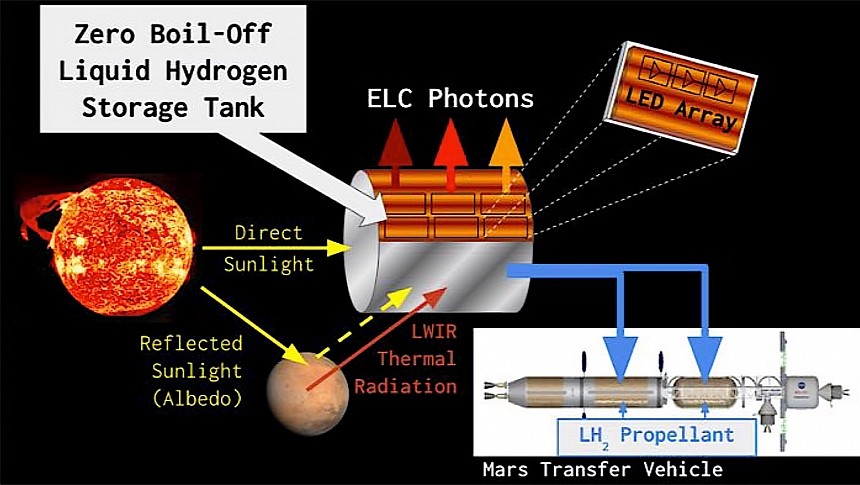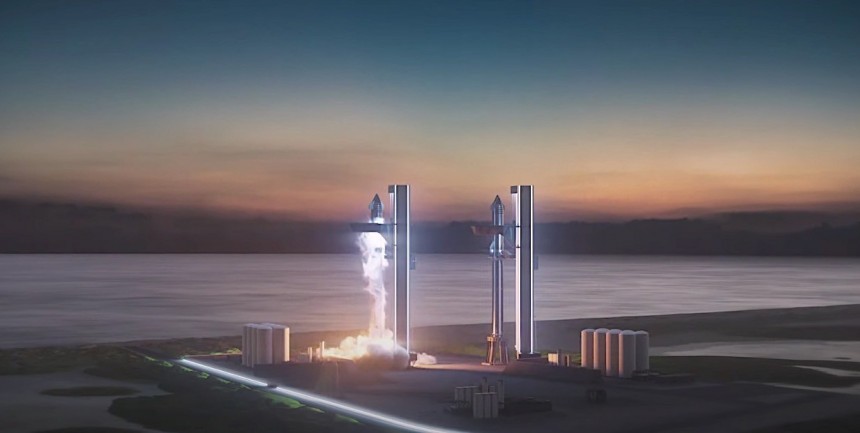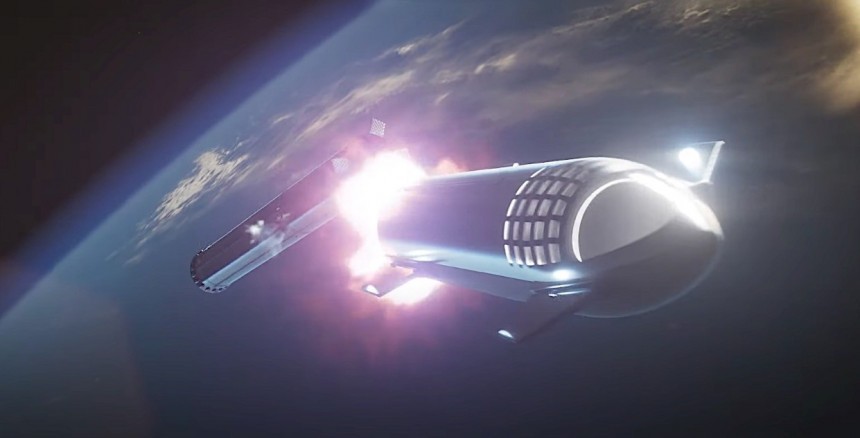2024 is not off to a great start when it comes to space exploration. The Peregrine lunar lander, the first such piece of tech launched by the US for the Moon in more than five decades, has failed unspectacularly after a flawless launch. It doing so, it could jeopardize the launch of the Artemis II mission, which is likely to be now pushed from late 2024 into the next year.
But such things, like them or not, are very common in this business, and by no means do they put an end to all of our efforts to expand our presence into the solar system. Proof of that are both the ongoing space programs, and the NASA Innovative Advanced Concepts (NIAC) program, which awards the most daring ideas in this field.
Like it does every year for a while now, NIAC announced at the beginning of the year the ideas it decided to back and bring them closer to fruition. Among them is something called the electro-luminescently cooled zero-boil-off propellant depot. A space gas station, if you will, meant to facilitate a human mission to Mars.
Mars is the farthest place in the solar system humans can dream of reaching themselves in a reasonable amount of time. In about seven months or so, a crewed spacecraft could reach the Red Planet and officially kickstart the spread of humanity to other worlds.
But, just like the Artemis program and the Peregrine mission have shown, things are a lot easier to do on paper. NASA has confirmed it's targeting a crewed flight to Mars, but before it does that it needs to make sure everything is in place and will work as advertised.
A while ago, the agency published a list of requirements, capabilities, and technologies needed for the success of such a daring project. Among the items on the list is a spacecraft's ability to refuel in space.
A trip to Mars would require immense amounts of fuel. I know, you will argue that we've sent missions there before, and fuel was not an issue, but you have to consider the fact a human mission will have to carry a lot of extra weight, not only from the humans themselves, but also from the supplies they need to survive for close to two years.
Launching a spacecraft filled to the brim with cargo from the surface of the planet is thus not feasible. That's probably why supplies will be sent in orbit, or even to Mars, beforehand, and the same can be done with fuel.
The problem is the kind of fuel rockets and spaceships use, and the fact it tends to boil off. When the conditions are right (and in space, they generally are), cryogenic fuel, the likes of liquid hydrogen, tends to evaporate and turn into useless vapor.
So, while the idea of having fuel storage depots placed in Earth's and Mars' orbits, or anywhere in between, is a good one, it can't be realized until some means of preventing boil-off is developed.
One of the NIAC ideas announced this year claims it can do just that. It's the electro-luminescently cooled zero-boil-off propellant depot I mentioned earlier, envisioned by someone named Aaswath Pattabhi Raman from over at the University of California, Los Angeles.
The scientists propose a zero boil-off storage tank for liquid hydrogen that can withstand the severe environment of the low-Earth orbit.
The secret to making the tank so capable is the fitting of thin all-solid-state panels affixed to its body. These are not regular panels, but ones that can use electro-luminescent cooling (ELC).
What is that, you ask? Well, it's been known for a while now that the conversion of electrons to photons in an LED could technically be used as a refrigeration tool. The only requirement is for the LED to be incredibly effective in performing the conversion.
In essence, the panels that use this tech will be rejecting heat from cold solid surfaces, helping the fuel inside the tank stay at a temperature comfortable enough to avoid boil-off – that would be around 20 degrees Kelvin (minus 253 degrees Celsius, minus 423 degrees Fahrenheit).
As per the brain behind the idea, such panels (the exact details on them are not known) would "drastically lower the cost and complexity of propulsion systems for crewed Mars missions and other deep space exploration."
Like all other NIAC ideas NASA has ever supported, this one too is subject to a lot of factors that may negatively affect its development. There is no guarantee it will work and no timeframe for a potential test of the technology.
The electro-luminescently cooled zero-boil-off propellant depot idea was one of 13 ideas selected this year for NIAC Phase 1. Stay close in the coming days to learn all we know about the others as well.
Like it does every year for a while now, NIAC announced at the beginning of the year the ideas it decided to back and bring them closer to fruition. Among them is something called the electro-luminescently cooled zero-boil-off propellant depot. A space gas station, if you will, meant to facilitate a human mission to Mars.
Mars is the farthest place in the solar system humans can dream of reaching themselves in a reasonable amount of time. In about seven months or so, a crewed spacecraft could reach the Red Planet and officially kickstart the spread of humanity to other worlds.
But, just like the Artemis program and the Peregrine mission have shown, things are a lot easier to do on paper. NASA has confirmed it's targeting a crewed flight to Mars, but before it does that it needs to make sure everything is in place and will work as advertised.
A while ago, the agency published a list of requirements, capabilities, and technologies needed for the success of such a daring project. Among the items on the list is a spacecraft's ability to refuel in space.
A trip to Mars would require immense amounts of fuel. I know, you will argue that we've sent missions there before, and fuel was not an issue, but you have to consider the fact a human mission will have to carry a lot of extra weight, not only from the humans themselves, but also from the supplies they need to survive for close to two years.
The problem is the kind of fuel rockets and spaceships use, and the fact it tends to boil off. When the conditions are right (and in space, they generally are), cryogenic fuel, the likes of liquid hydrogen, tends to evaporate and turn into useless vapor.
So, while the idea of having fuel storage depots placed in Earth's and Mars' orbits, or anywhere in between, is a good one, it can't be realized until some means of preventing boil-off is developed.
One of the NIAC ideas announced this year claims it can do just that. It's the electro-luminescently cooled zero-boil-off propellant depot I mentioned earlier, envisioned by someone named Aaswath Pattabhi Raman from over at the University of California, Los Angeles.
The scientists propose a zero boil-off storage tank for liquid hydrogen that can withstand the severe environment of the low-Earth orbit.
The secret to making the tank so capable is the fitting of thin all-solid-state panels affixed to its body. These are not regular panels, but ones that can use electro-luminescent cooling (ELC).
In essence, the panels that use this tech will be rejecting heat from cold solid surfaces, helping the fuel inside the tank stay at a temperature comfortable enough to avoid boil-off – that would be around 20 degrees Kelvin (minus 253 degrees Celsius, minus 423 degrees Fahrenheit).
As per the brain behind the idea, such panels (the exact details on them are not known) would "drastically lower the cost and complexity of propulsion systems for crewed Mars missions and other deep space exploration."
Like all other NIAC ideas NASA has ever supported, this one too is subject to a lot of factors that may negatively affect its development. There is no guarantee it will work and no timeframe for a potential test of the technology.
The electro-luminescently cooled zero-boil-off propellant depot idea was one of 13 ideas selected this year for NIAC Phase 1. Stay close in the coming days to learn all we know about the others as well.





















